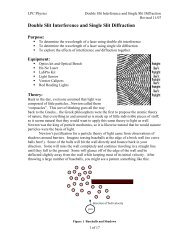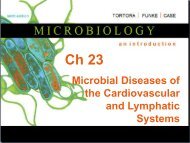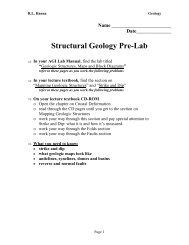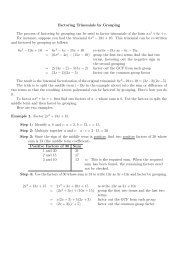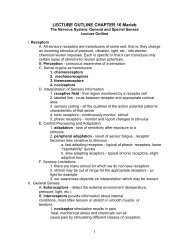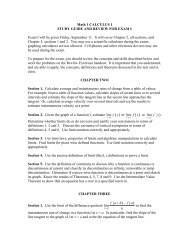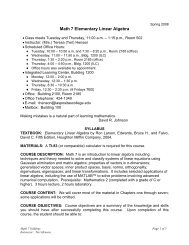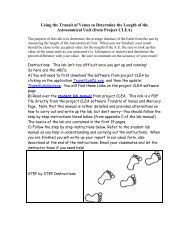The Eukaryotes: Fungi, Algae, Protozoa, and Helminths
The Eukaryotes: Fungi, Algae, Protozoa, and Helminths
The Eukaryotes: Fungi, Algae, Protozoa, and Helminths
You also want an ePaper? Increase the reach of your titles
YUMPU automatically turns print PDFs into web optimized ePapers that Google loves.
Ch 12<br />
<strong>The</strong> <strong>Eukaryotes</strong>:<br />
<strong>Fungi</strong>, <strong>Algae</strong>,<br />
<strong>Protozoa</strong>, <strong>and</strong><br />
<strong>Helminths</strong><br />
Copyright © 2010 Pearson Education, Inc.
Student Learning Outcomes<br />
• List the defining characteristics of fungi.<br />
• Identify two beneficial <strong>and</strong> two harmful effects of fungi.<br />
• List the defining characteristics of protozoa.<br />
• Differentiate an intermediate host from a definitive host.<br />
• List the distinguishing characteristics of the two classes of<br />
parasitic helminths, <strong>and</strong> give an example of each.<br />
• Provide a rationale for the elaborate life cycles of parasitic<br />
worms.<br />
• Define arthropod vector.<br />
• Differentiate between a tick <strong>and</strong> a mosquito, <strong>and</strong> name a<br />
disease transmitted by each.<br />
Copyright © 2010 Pearson Education, Inc.
FUNGI<br />
• Chemoheterotroph, aerobic<br />
(molds) or facultatively<br />
anaerobic (yeasts)<br />
• Mycology: Study of fungi<br />
• Most fungi decomposers, few<br />
are parasites of plants <strong>and</strong><br />
animals.<br />
• # of serious fungal infections<br />
increasing<br />
Fig. 12.1<br />
Review Table 12.2<br />
Copyright © 2010 Pearson Education, Inc.
Characteristics of <strong>Fungi</strong><br />
• Hyphae: Filaments of cells,<br />
mostly septate<br />
• Mycelium: Mass of hyphae.<br />
• Molds: mostly filamentous.<br />
• Yeasts: nonfilamentous, unicellular fungi.<br />
• Budding yeasts divide asymmetrically.<br />
• Dimorphic fungi: yeasts like 37C, molds 25C.<br />
• Fungal spores differ from bacterial spores. Form from<br />
aerial hyphae.<br />
• Growth in acidic, low-moisture, high osmotic pressure<br />
environments.<br />
• Copyright Metabolize © 2010 Pearson Education, Inc. complex carbohydrates (e.g.: lignin).
Economic Effects of <strong>Fungi</strong><br />
• Saccharomyces cerevisiae: Bread, wine, HBV<br />
vaccine<br />
• Trichoderma: Cellulase<br />
• Taxomyces: Taxol<br />
• Entomophaga: Biocontrol<br />
• Paecilomyces: Kills termites<br />
• Mold spoilage<br />
Copyright © 2010 Pearson Education, Inc.
Fungal Diseases – Mycoses<br />
1. Systemic mycosis: infection deep within body,<br />
affects many tissues <strong>and</strong> organs. Histoplasmosis <strong>and</strong><br />
coccidiomycosis.<br />
2. Subcutaneous mycosis: Saprophytic fungi, e.g.:<br />
Sporotrichosis.<br />
3. Cutaneous mycosis = Dermatomycosis: affects<br />
keratin-containing tissues (hair, nails, skin).<br />
4. Superficial mycosis: localized on hair shafts <strong>and</strong><br />
superficial skin cells.<br />
Opportunistic mycoses:<br />
• caused by normal microbiota or fungi that are not<br />
usually pathogenic (E.g.: C<strong>and</strong>idiasis <strong>and</strong><br />
Pneumocystis pneumonia)<br />
• usually systemic.<br />
Copyright © 2010 Pearson Education, Inc.
Human eyelash<br />
with unknown<br />
fungus infection.<br />
Minimal damage to<br />
skin or underlying<br />
tissues.<br />
However, impaired<br />
IS can encourage<br />
the infecting fungus<br />
to proliferate.<br />
Copyright © 2010 Pearson Education, Inc.
ALGAE<br />
Mostly photoautotrophs,<br />
mostly in ocean<br />
Diatoms<br />
• Unicellular, store<br />
energy in form of oil<br />
• Domoic acid Neurological disease<br />
• Ingestion of mussels that fed on diatomes (also<br />
affects birds <strong>and</strong> sealions)<br />
Dinoflagellates (plankton)<br />
• Some produce neurotoxins: red tide<br />
• Kills fish, marine mammals, <strong>and</strong> humans, e.g.:<br />
parasitic shellfish poisoning (PSP)<br />
Copyright © 2010 Pearson Education, Inc.
PROTOZOA<br />
Unicellular,<br />
eukaryotic<br />
chemoheterotrophs. Large <strong>and</strong> diverse group. Few<br />
are pathogenic.<br />
Found in soil <strong>and</strong> water <strong>and</strong> as normal microbiota in<br />
animals.<br />
Trophozoite: Vegetative form (feeding <strong>and</strong> growing).<br />
Asexual reproduction via fission, budding, or<br />
schizogony (multiple fission).<br />
Sexual reproduction via conjugation.<br />
Some protozoa can produce a cyst that provides<br />
protection during adverse environmental conditions.<br />
Copyright © 2010 Pearson Education, Inc.
Medically Important <strong>Protozoa</strong><br />
1. Arcaezoa (lack mitochondria)<br />
• Trichomonas <strong>and</strong><br />
• Giardia<br />
2. Microspora (no mitochondria <strong>and</strong> no microtubules)<br />
– diarrhea <strong>and</strong> keratoconjunctivitis in AIDS patients<br />
3. Amoebozoa (move via pseudopodia)<br />
• Entamoeba (dysentery) <strong>and</strong> Acanthamoeba<br />
4. Apicomplexa: not mobile, intracellular<br />
• Plasmodium, Babesia, Toxoplasma, Cryptosporidium<br />
5. Euglenozoa: Hemoflagellates<br />
• Trypanosoma<br />
Copyright © 2010 Pearson Education, Inc.
Amoebozoa<br />
• Move by<br />
pseudopods<br />
• Entamoeba<br />
• Acanthamoeba<br />
Copyright © 2010 Pearson Education, Inc.
<strong>The</strong> Life Cycle of Plasmodium vivax<br />
2<br />
3<br />
8<br />
7<br />
6<br />
Fig 12.18
Euglenozoa<br />
• Move by flagella<br />
• Hemoflagellates<br />
• Trypanosoma spp.<br />
Sleeping<br />
sickness<br />
Chagas’<br />
disease<br />
Copyright © 2010 Pearson Education, Inc.<br />
Fig 23..22
HELMINTHS (Parasitic Worm)<br />
• Kingdom: Animalia<br />
• Phylum: Platyhelminthes<br />
(flatworms)<br />
Class: Trematodes (flukes)<br />
Class: Cestodes (tapeworms)<br />
• Phylum: Nematoda (roundworms)<br />
• few are human parasites<br />
• Anatomy <strong>and</strong> life cycle modified for<br />
parasitism<br />
• Adult stage in definitive host.<br />
• Each larval stage in specific<br />
Copyright intermediate © 2010 Pearson Education, Inc. host.
Life Cycle of <strong>Helminths</strong><br />
• Monoecious (hermaphroditic)<br />
• Male <strong>and</strong> female reproductive systems in one animal<br />
• Dioecious<br />
• Separate male <strong>and</strong> female<br />
• Egg larva(e) adult<br />
Copyright © 2010 Pearson Education, Inc.
Platyhelminths<br />
• Dorsoventrally flattened<br />
Trematode, or fluke: Oral <strong>and</strong> ventral sucker attaches<br />
to host tissue<br />
• Cestode, or tapeworm: Scolex (head), proglottids<br />
4 suckers <strong>and</strong><br />
rostellum with hooks<br />
Fig 12.26<br />
Gravid proglottid with<br />
uterine branches
Taenia solium<br />
Taenia saginata<br />
Copyright © 2010 Pearson Education, Inc.<br />
Human definitive host;<br />
pig or cattle intermediate host.
Echinococcus granulosus<br />
Fig. 12. 27
Human as<br />
Human is ….<br />
Definitive Host<br />
Taenia saginata<br />
Cysticerci in beef<br />
muscle<br />
Intermediate Host<br />
Echinococcus<br />
granulosus<br />
Adult in dog
.<br />
Nematodes<br />
Roundworms have a complete digestive system<br />
Eggs infective for humans:<br />
• Ascaris lumbricoides: Ascariasis. 2 nd most<br />
common worm infection in US. (Most common<br />
worldwide; > 1 bio infected)<br />
• Enterobius vermicularis (pinworm). Most<br />
common worm infection in US (30% of<br />
children, 16% of adults infected)<br />
•<br />
Copyright © 2010 Pearson Education, Inc.
Pinworm / Enterobius vermicularis<br />
Copyright © 2010 Pearson Education, Inc.<br />
Fig12.28
Do test immediately<br />
after waking up.<br />
Several samples<br />
might need to be<br />
examined.<br />
Since scratching of<br />
the anal area is<br />
common, samples<br />
taken from under the<br />
fingernails may also<br />
contain eggs.<br />
Diagnosing Pinworm Disease<br />
pinworm paddle
Larvae Infective for Humans<br />
Fig 25.23<br />
Hookworms<br />
Ancylostoma duodenale <strong>and</strong><br />
Copyright Necator © 2010 Pearson Education, americanus<br />
Inc.
Trichinellosis:<br />
<strong>The</strong> Life Cycle of Trichinella spiralis
<strong>The</strong> Heartworm Dirofilaria immitis<br />
Primarily in dogs <strong>and</strong> cats human heart failure,<br />
also in human lungs<br />
Spread via mosquitoes<br />
Copyright © 2010 Pearson Education, Inc.<br />
Fig 12.29
ARTHROPODS AS VECTORS<br />
Kingdom: Animalia<br />
• Phylum: Arthropoda (exoskeleton, jointed legs, segmented body)<br />
Class: Insecta (6 legs)<br />
Lice, fleas, mosquitoes<br />
Class: Arachnida (8 legs)<br />
Mites <strong>and</strong> ticks<br />
• Arthropods that carry diseases are called vectors.<br />
• Elimination of vectorborne<br />
diseases best via control or<br />
eradication of vectors.<br />
Copyright © 2010 Pearson Education, Inc.
Arthropod Vectors<br />
• Mechanical transmission<br />
• Biological transmission<br />
• Microbe multiplies in vector<br />
• Definitive host<br />
• Microbe’s sexual reproduction in vector<br />
Fig 12.32<br />
Copyright © 2010 Pearson Education, Inc.



